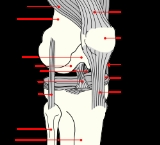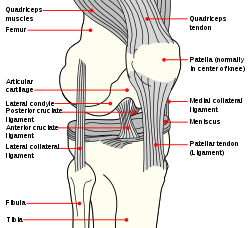
Patellar dislocation
Encyclopedia
Patellar dislocations occur with significant regularity, particular in young female athletes. It involves the patella sliding out of its position on the knee, most often laterally, and may be associated with extremely intense pain and swelling. The patella can be tracked back into the groove with an extension of the leg, and therefore sometimes returns into the proper position on its own.
 The patella rests in the patellofemoral groove, a cavity located on the knee
The patella rests in the patellofemoral groove, a cavity located on the knee
between the distal femur
and the tibia
. The sides of the patella attach to certain ligament
s and tendon
s to stabilize and support it. The superior border of the patella attaches to the common tendon of the quadriceps muscles, the medial borders are attached to the vastus medialis muscle, and the inferior border is connected to the tibial tuberosity. The main ligament stabilizer, the patellofemoral ligament, rests directly over the femur and the patella while the lateral and medial collateral ligaments act as the secondary ligament stabilizers from either side of the patella.
Sports commonly associated with patellar dislocation include soccer, gymnastics and ice hockey. The patella wobbles out of the patellofemoral groove, usually to the lateral side of the knee (away from the middle of the body). This occurs when the quadriceps tendons and other ligament stabilizers attached to the borders of the patella contract forcefully as the knee is rotating, pulling the patella out of place.
Age:
• Average age of occurrences for patellar dislocation is 16–20 yrs old
• Primarily due to increased participation in sports and recreation
Gender:
• Female are more susceptible to patellar dislocation
Athletic Population :
• Particularly in sports with twisting, rotational motion of the knee
• Direct trauma to the knee
2) Positive Family History
• Related up to 24% of patellar dislocation incidences
3) Anatomical Factors
Excessive Q-angle
• Angle greater than 25 degrees between the patellar tendon and quadriceps muscle
Misalignment of the patella on the knee joint
• Due to malformed patella/knee joint, patella situated abnormally higher on the knee than normal
Insufficient Vastus Medialis Obliquus Muscle (VMO))
• Normal function is to keep patella in stable position
• If function is decreased, will result in instability of the patella
To assess the knee, the Patellar Apprehension Test may be done in which the patella is moved back and forth while the knee is flexed at approximately 30 degrees.
Also, a patella tracking assessment can be performed by the patient making a single leg squat and stand or, alternatively, lying supine with knee extended from flexed position. A patella that abruptly deviates medially on early flexion is called the , and indicates imbalance between vastus medialis
and lateral forces.
Two types of treatment options are typically available:
•surgery (open or arthroscopic)
•conservative treatment (rehabilitation).
Regardless of the treatment option chosen, a rehabilitation program of usually 6–16 weeks will follow. Choosing an appropriate treatment depends on a number of factors, including associated injuries with bone fragments or injuries to the soft tissues around the knee. Also things like the patients age, sports and activities they participate in, level of competition, and time needed to return to work and/or sport participation are all very important factors to consider. According to most research, surgery is strongly suggested in cases where other structures in the knee are severely damaged, or specifically when there is:
• Concurrent osteochondral injury
• Continued gross instability
• Palpable disruption of the medial patellofemoral ligament and the vastus medialis obliquus
• High-level athletic demands coupled with mechanical risk factors and an initial injury mechanism not related to contact
Research appears to indicate that the conservative approach, avoiding surgery, is the preferred method of treatment wherever possible. In comparing the rates of re-injury, function of the knee, and patients subjective opinions of their knee function and stability, the best available evidence found no significant differences between surgical and conservative treatments This suggests surgery is much less desirable, as there are inheritant complications that can arise from surgery, such as adverse reaction to anesthesia, as well as infections. In particular, surgery for children or adolescents who have not completely matured skeletally are contraindicated, as there is a risk that surgery may injure growth structures in the knee.
Supplements like glucosamine
and NSAID's could be used to keep the knee strong.
Anatomy of the knee

Knee
The knee joint joins the thigh with the leg and consists of two articulations: one between the fibula and tibia, and one between the femur and patella. It is the largest joint in the human body and is very complicated. The knee is a mobile trocho-ginglymus , which permits flexion and extension as...
between the distal femur
Femur
The femur , or thigh bone, is the most proximal bone of the leg in tetrapod vertebrates capable of walking or jumping, such as most land mammals, birds, many reptiles such as lizards, and amphibians such as frogs. In vertebrates with four legs such as dogs and horses, the femur is found only in...
and the tibia
Tibia
The tibia , shinbone, or shankbone is the larger and stronger of the two bones in the leg below the knee in vertebrates , and connects the knee with the ankle bones....
. The sides of the patella attach to certain ligament
Ligament
In anatomy, the term ligament is used to denote any of three types of structures. Most commonly, it refers to fibrous tissue that connects bones to other bones and is also known as articular ligament, articular larua, fibrous ligament, or true ligament.Ligament can also refer to:* Peritoneal...
s and tendon
Tendon
A tendon is a tough band of fibrous connective tissue that usually connects muscle to bone and is capable of withstanding tension. Tendons are similar to ligaments and fasciae as they are all made of collagen except that ligaments join one bone to another bone, and fasciae connect muscles to other...
s to stabilize and support it. The superior border of the patella attaches to the common tendon of the quadriceps muscles, the medial borders are attached to the vastus medialis muscle, and the inferior border is connected to the tibial tuberosity. The main ligament stabilizer, the patellofemoral ligament, rests directly over the femur and the patella while the lateral and medial collateral ligaments act as the secondary ligament stabilizers from either side of the patella.
Mechanism of injury
Patellar dislocations occur in 2 ways:- Direct blow to the kneecap knocking the patella out of place
- Awkward twisting motions of the knee
Sports commonly associated with patellar dislocation include soccer, gymnastics and ice hockey. The patella wobbles out of the patellofemoral groove, usually to the lateral side of the knee (away from the middle of the body). This occurs when the quadriceps tendons and other ligament stabilizers attached to the borders of the patella contract forcefully as the knee is rotating, pulling the patella out of place.
Predisposing factors
1) DemographicsAge:
• Average age of occurrences for patellar dislocation is 16–20 yrs old
• Primarily due to increased participation in sports and recreation
Gender:
• Female are more susceptible to patellar dislocation
Athletic Population :
• Particularly in sports with twisting, rotational motion of the knee
• Direct trauma to the knee
2) Positive Family History
• Related up to 24% of patellar dislocation incidences
3) Anatomical Factors
Excessive Q-angle
• Angle greater than 25 degrees between the patellar tendon and quadriceps muscle
Misalignment of the patella on the knee joint
• Due to malformed patella/knee joint, patella situated abnormally higher on the knee than normal
Insufficient Vastus Medialis Obliquus Muscle (VMO))
• Normal function is to keep patella in stable position
• If function is decreased, will result in instability of the patella
Symptoms and signs
There will be swelling and impaired mobility following patellar dislocation. Pain is usually described as being “inside the knee cap”. If displaced, the leg would have a tendency to flex even when relaxed.To assess the knee, the Patellar Apprehension Test may be done in which the patella is moved back and forth while the knee is flexed at approximately 30 degrees.
Also, a patella tracking assessment can be performed by the patient making a single leg squat and stand or, alternatively, lying supine with knee extended from flexed position. A patella that abruptly deviates medially on early flexion is called the , and indicates imbalance between vastus medialis
Vastus medialis
The vastus medialis , often called the 'teardrop' muscle, is a medially located muscle of the quadriceps.-Function:The vasti appear to act largely in a co-ordinated manner throughout the control of knee extension...
and lateral forces.
Treatment options
Most people are able to pop the patella back into place, in which a “snap” is heard upon complete leg extension.Two types of treatment options are typically available:
•surgery (open or arthroscopic)
•conservative treatment (rehabilitation).
Regardless of the treatment option chosen, a rehabilitation program of usually 6–16 weeks will follow. Choosing an appropriate treatment depends on a number of factors, including associated injuries with bone fragments or injuries to the soft tissues around the knee. Also things like the patients age, sports and activities they participate in, level of competition, and time needed to return to work and/or sport participation are all very important factors to consider. According to most research, surgery is strongly suggested in cases where other structures in the knee are severely damaged, or specifically when there is:
• Concurrent osteochondral injury
• Continued gross instability
• Palpable disruption of the medial patellofemoral ligament and the vastus medialis obliquus
• High-level athletic demands coupled with mechanical risk factors and an initial injury mechanism not related to contact
Research appears to indicate that the conservative approach, avoiding surgery, is the preferred method of treatment wherever possible. In comparing the rates of re-injury, function of the knee, and patients subjective opinions of their knee function and stability, the best available evidence found no significant differences between surgical and conservative treatments This suggests surgery is much less desirable, as there are inheritant complications that can arise from surgery, such as adverse reaction to anesthesia, as well as infections. In particular, surgery for children or adolescents who have not completely matured skeletally are contraindicated, as there is a risk that surgery may injure growth structures in the knee.
Supplements like glucosamine
Glucosamine
Glucosamine is an amino sugar and a prominent precursor in the biochemical synthesis of glycosylated proteins and lipids. Glucosamine is part of the structure of the polysaccharides chitosan and chitin, which compose the exoskeletons of crustaceans and other arthropods, cell walls in fungi and...
and NSAID's could be used to keep the knee strong.

